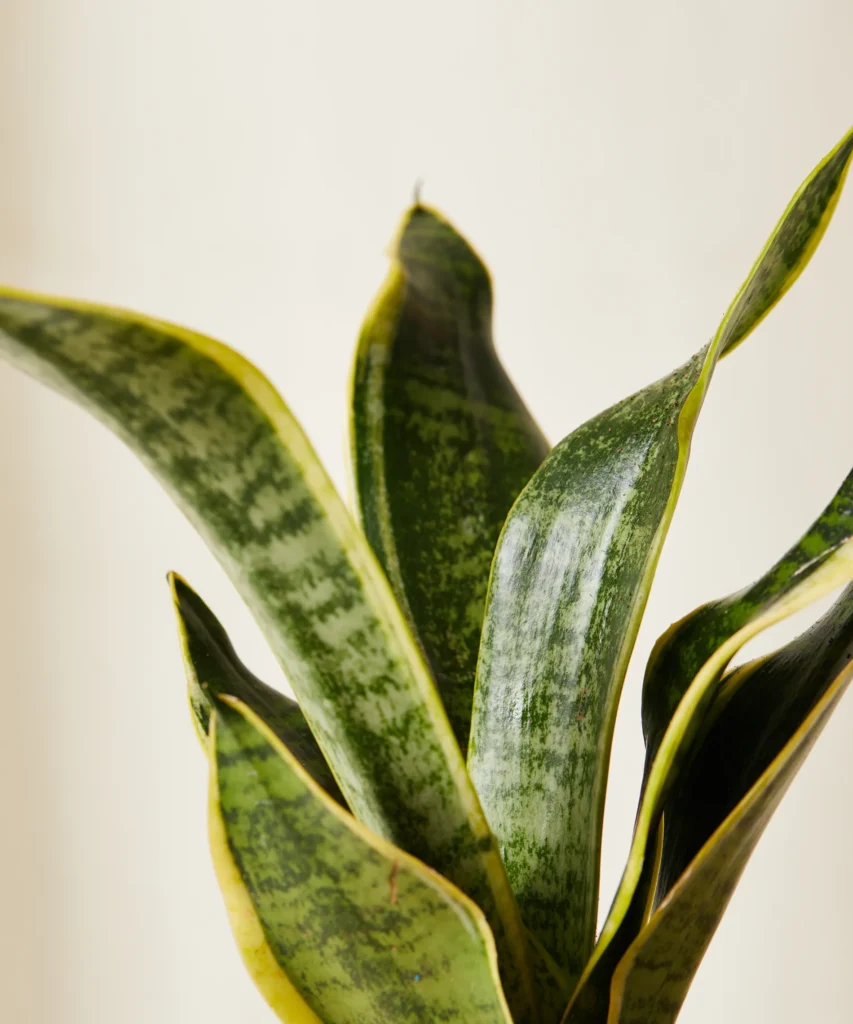Snake Plant (Sansevieria) Care
If you’re new to plant ownership or are simply looking for an easy-care houseplant, a Snake Plant is the plant for you. These hardy plants remain popular because of their adaptability to a wide range of growing conditions.

How to care for your Snake Plant
- LIGHT
Your Snake Plant can tolerate any light level. The brighter the light, the faster it will grow. Always acclimate the plant over a few weeks if moving from indirect to direct light to avoid scorching the foliage.
- WATER
Water only when the soil volume is 100% dry. It’s better to err on the dry side. Water thoroughly to encourage a healthy root system and discard any excess water in the saucer.
- HUMIDITY
Your Sansevieria prefers a dry environment. No need to mist.
- TEMPERATURE
Temperatures ranging from 55-85°F are fine for your Snake Plant. Warmer temperatures encourage faster growth.
- FOOD
Feed once every six months with a liquid fertilizer for indoor plants.
- TOXICITY
Snake Plants are toxic to humans and pets if ingested.
- ADDITIONAL CARE
Snake Plants reproduce by growing new plants (or ‘‘pups’’) near the base of the mother plant. To propagate your Snake Plant, carefully remove the leaves and stems of each pup once they become a few inches tall and plant them into a new pot.
Common Issues for your Snake Plant
Soil dry for too long
Your Sansevieria is very drought-tolerant, but that doesn’t mean you can forget about it completely. Be sure you’re not over or underwatering your plant. Keep a consistent watering schedule–water when the top 50% of the soil is dry.
If you accidentally leave your Sansevieria’s soil completely dry for too long, you may see leaves go limp, droop, and possibly start to brown and curl. If the soil is extremely dry all the way through the pot, a thorough soak is in order.
Here’s how to soak-water your Sansevieria:
- Place your plant in your sink or tub without the saucer. Fill your basin up with about 3-4″ of water. Make sure the water isn’t hot!
- Allow your plant to soak up water through the drainage hole in the bottom of the pot for at least 45 min.
- Feel the top of the soil after your plant has been soaking–has the water reached the top 2-3” of soil?
- If not all the soil feels saturated, water your Sansevieria lightly from the top of the soil to help speed up the saturation.
- When your plant’s soil is evenly damp, drain the sink/tub and allow the plant to rest while it drains thoroughly. Place the plant back on its saucer and back in its proper spot.
Moisture
Providing proper soil moisture (or lack of moisture) is important in caring for a Sansevieria. The number one cause of yellowing leaves among Sansevieria plants is overwatering. Sansevieria basically thrive off of neglect–they don’t need much water to survive. Only water when the top 50% of soil is dry. Water until water flows freely from the drainage hole at the bottom of the pot. Be sure to discard any excess water that flows into the saucer. Your Sansevieria doesn’t like “wet feet,” as this can lead to root rot and eventual death of your Sansevieria.
Your watering consistency
Alternating between bone dry and wet soil from ill-timed waterings can create stress and cause your Sansevieria to have yellow leaves.
Pests
Weakened or stressed Sansevierias become more susceptible to insect infestations. Sap-sucking bugs like spider mites can drain your plant of moisture. This problem quickly manifests itself by yellowing leaflets and fronds. Scale, mealybugs, and spider mites occur frequently in indoor conditions. If not killed early on, these small pests proliferate and move all along the leaves and blades. The piercing mouths of the insects exhaust your plant and accelerate yellowing, especially if your Sansevieria is already unhealthy from a nutrient deficiency or improper soil moisture.
Underwatering
The snake plant is known to be difficult to kill and doesn’t need a lot of water, thanks to its semi-succulent leaves. However, prolonged dry spells can create stress and cause your plant to have soft, floppy leaves that can have a tendency to tip. It’s important to note that if the plant stays dry for too long, the roots can start to shrivel and die back.
Overwatering
Many of us love our watering routine and go around watering all of our indoor plants on the same schedule. But this approach can lead to watering certain plants too often. If you’re overwatering your snake plant, it can begin to rot at the base of the leaves, causing it to lean and droop to one side. Water only when the soil is 100% dry, from the top to the bottom of the pot. Always check the soil before watering to make sure it needs it. Thoroughly water until you see it absorb into the soil and eventually flow out of the drainage hole. Discard any excess water that accumulates in the saucer.
Lack of Fertilizer
If your snake plant is on an excellent watering schedule and still leaning over, it might be asking for some additional nutrients. While water and sunlight give the plant most of its needs, it also requires nutrients like phosphorus, nitrogen, and potassium. It’s a good idea to feed your snake plant once in the spring and once in the summer.
Lack of Light
A lean in your sansevieria might be its way of stretching to get closer to its light source. Though they tolerate low light, sansevierias thrive in high light, so move it closer to a window and rotate your plant monthly to fix this issue.
